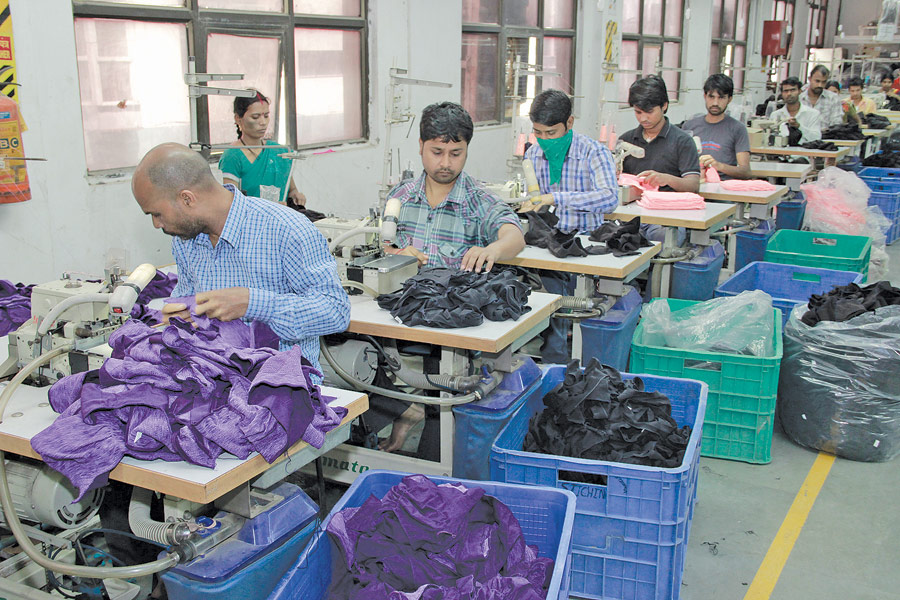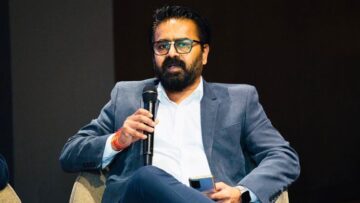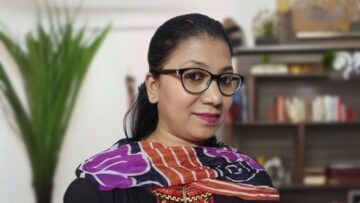
Seamless clothing started with a bang in India with Personal Creations, Flying Fashion and Precise Seamless Apparels (PSA) making their initial investment in seamless knitting machines around the same time in 2008. In the ‘November 2008 issue of StitchWorld’, the investment, strategies and future plans of all these three companies was highlighted along with the nitty-gritty of manufacturing seamless clothing. Now in 2015, only one of these three companies – Precise Seamless Apparels, has prospered in exporting seamless clothing from India, while Flying Fashions has closed the division, Personal Creations have not moved beyond its initial size of 21 seamless knitting machines. Revisiting Precise Seamless Apparels, which now has a setup of 100 seamless knitting machines, StitchWorld highlights the key to success in manufacturing and exporting seamless knitwear in an exclusive interaction with Tarun Jindal, Director, Precise Seamless Apparels.

With a clear agenda to work in the seamless garment segment, Precise Seamless Apparels (PSA) was established with a setup of 12 seamless knitting machines. Today the company boasts of 100 seamless knitting machines and 200 sewing machines. Dealing majorly with the American market, Kohl’s, Macy’s and GAP are some of the biggest buyers of PSA. “Kohl’s is the biggest among all, in terms of the volumes, occupying 40-45% of our total capacity, followed by GAP, which would be occupying 30-35% of the capacity; 5% to 10% of the capacity is occupied by other buyers such as Quiksilver, Academy, Roxy and then we have an open capacity of 25% reserved for Kohl’s and GAP, in case they increase the order volumes. This 25% capacity has not been sold to any buyer and this capacity is left for excess requirements,” explains Tarun. PSA has stuck with the US buyers because of the volumes offered by them, unlike the European market that offers low quantities such as 2,000 pieces, which are equivalent to a trial order for the American market. “Even the Canadian market is better in terms of quantities then the European market,” adds Tarun.
China peaked as the manufacturer of seamless clothing only for a short while but now the top spot is held by Israel, housing companies such as Tefron and Delta Galil. Israel is followed by Sri Lanka, China and India. But the products made by every country are more or less similar in the construction, but the yarns used are different.
Majorly manufacturing camisoles, tanks, leggings and sports bras, PSA caters to the segment of sportswear and activewear clothing – both the categories are showing remarkable growth in the US market. With sales accounting for US $ 33.7 billion and 16% of the total US apparel retail, activewear buoyed the total US apparel market from July ’13 to June ’14, helping total apparel sales to reach US $ 206.3 billion, a 1% increase over the prior year, according to leading global information company NPD Group. “People are looking for more comfortable clothing,” reiterates Tarun. The FOBs for such products fall between US $ 2.3 to US $ 8. “Value wise sports bras are the most rewarding but camisoles and tank tops offer the most quantities. The reason for the same is that a sports bra has two layers of fabric unlike camisoles and tank tops which have just one single layer. The machine knits two layers and then links them together automatically,” shares Tarun. PSA also imparts performance finishes such as anti-static, anti-microbial, fast wicking, quick dry, etc. “These properties can either be incorporated at the yarn stages or at the tube stages. But it is cheaper to impart the property as a finish at the tube stages,” avers Tarun.

Sourcing yarns from Sri Lanka and Italy, PSA uses cationic dyeable yarns, polyester, nylon, nylon 66, modal and cotton. “Instead of dyeing yarns, we prefer dyeing knitted tube because the former is more expensive, as it requires a more comprehensive setup in terms of the space, machinery and infrastructure required,” shares Tarun. The company is not sourcing such yarns from India because of a limited variety in the yarn counts to choose from and is of relatively poor quality. Since seamless is about body-hugging garments that are comfortable, the use of elastane/spandex is a normal practice. “One of the biggest advantages of seamless technology as against conventional knitting is that we can blend up to 30% spandex for maximum stretch, whereas in conventional knits, it is difficult to blend in more than 10-15% spandex,” says Tarun. Equally decisive to quality of the end-product is the yarn count, which defines the weight and softness of the seamless garment.
Interestingly, competition for PSA has faded not only from India, but also at the global level. “We are actually gaining business from China as my prices and practices are better than those offered by the Chinese vendors. Due to my partnership with raw materials suppliers, I am able to get the best price of yarns and other raw materials. This is a major cost saving. Secondly, Chinese vendors were found to be indulging in fraudulent practices such as producing seamless knitwear with Nylon 6 and charging the buyer for Nylon 66,” points out Tarun. According to him, China peaked as the manufacturer of seamless clothing only for a short while but now the top spot is held by Israel, housing companies such as Tefron and Delta Galil. Israel is followed by Sri Lanka, China and India. “Every country has a fixed set of buyers, so there is no competition as such. Moreover, unlike cut & sew apparels, it is not easy to replicate a seamless garment in a new factory or different location. The products made by every country are more or less similar in the construction but the yarns used are different,” highlights Tarun.

Success in the niche product segment is majorly attributed to the intense training programme undertaken by Tarun Jindal in Italy, which made him a qualified technician of the seamless knitting machines and an equally good design developer. “The course that I did was focused on automating the complete process of apparel manufacturing while merging the two entities of Fashion and Business,” explains Tarun. But technical know-how is just one part of the business and Tarun still finds it challenging to reduce the time required for shipment of yarns from 50 to 60 days. To overcome this roadblock, at any given point of time, PSA has 5-6 tonnes of yarn in stock, which is enough for two months production. “Every 3 months there is a new development in yarns. Hence we have to be in constant touch with the yarn suppliers. Moreover, the buyers that we work with give us a forecast which helps us in better planning. For example, we are working with Kohl’s and they give us business throughout the year. Every month they give us the forecast for the coming season and we in-house our yarns accordingly,” states Tarun.
With a turnover of US $ 35 million and looking at 30% growth, PSA has plans of adding 30 more seamless knitting machines before the end of 2015, which is part of the bigger plan to have 200 seamless knitting machines by the end of 2016. “People tried doing seamless apparels as a complementary business along with other business, which cannot be done. Whereas we focused only on this product category and moved with the market,” avers Tarun.
It takes 6-7 minutes to knit a tube with the shaping of a camisole; 5-6 hours are required for dyeing, and within 9 hours a camisole is ready. With its current capacity, PSA produces 25,000 pieces per day.
Manufacturing
A total of 40 operators and 4 technicians handle the 100 seamless knitting machines all from Santoni at PSA, and although the machine does the knitting, technicians are critical to the output of the machine, its downtime and adherence to the design as they understand and act as per the various indications showed by the machine. “Since this technology is very similar to that of making socks, so we hire operators and technicians of sock knitting machines, and train them for handling seamless machines. Every 6 months a team of technicians from Santoni visits us. They check the machines and also train the operator and technicians,” shares Tarun. Equal importance needs to be given to the environment within the facility as nylon shrinks with heat and even starts yellowing, due to which the complete yarn storage and knitting section are centrally air-conditioned, only the dyeing and the sewing segment are normally air-cooled.
Seamless knitting machines only use man-made fibres for producing seamless clothing as cotton yarn being relatively brittle in nature cannot withstand the high-operating speeds of the knitting machines. Precise Seamless is using the TOP2 and EVO4 single jersey seamless knitting machines from Santoni. The TOP2 has a gauge range of 16 to 40 inches whereas EVO4 has a gauge range of 16 to 32. Even the needle gauge varies, TOP2 has a needle gauge range of 48 to 80 gg and EVO8 has a needle gauge range of 48 to 75 gg. Although having 8 yarn feeders each, theTOP2 has 8 yarn fingers per yarn feeder and EVO8 has 10 yarn fingers per yarn feeder.

It takes 6-7 minutes to knit a tube with the shaping of a camisole; 5-6 hours are required for dyeing, and within 9 hours a camisole is ready. With its current capacity, PSA produces 25,000 pieces per day. In reality, seamless apparels are not completely ‘seamless’ as a significant amount of cutting and sewing operations are required for making the final garment. “The seamless knitting machines produce a tube with shaping of a sports bra, camisole or tank top. Then the tube is dyed, subsequent to which the tube is shaped, i.e. cut and sewn at the same time on an overlock sewing machine. Finally, the garment is made ready with attachment of straps, waistbands and binding tapes,” explains Tarun. The typical waste values that can be expected for different garments are 54% for thong, 25% in case of panty, 9% in camisole and 5% in T-shirt, but the same can be reduced by using seamless knitting machines with a reciprocating cylinder.
The sewing section of the company has 200 sewing machines, which is enough to handle the knitting capacity. “Not every type of seamless clothing requires sewing. Products such as bandeau, tube tops & swim cover-ups, which we supply regularly to our current customers do not require any kind of sewing after knitting,” adds Tarun. The company has even experimented with bonded and welded technology but is yet to invest in such machines.
For its specific needs, the company has invested in sewing machines from the Italian company Rimoldi and Japanese pioneer Yamato along with bartack machines from Juki, as apt sewing equipment is necessary for handling seamless knitwear products because of the occurrence of curling of the edges after the tube has been shaped into the final garment. Installed are Yamato’s VF 2500-8 interlock machine with active thread control, FD-62G flat seamer feed-off-the-arm machine and ABT20 overlock machine with straight chain casting. All three machines are suitable for micro-fibre and fine knits, and guarantee stain free sewing.
Available in 2- and 3-needle options and 4- and 5-thread options, the VF 2500 interlock machine guarantees tensionfree seams with its active seam control mechanism, which regulates the thread tension according to the need instead of keeping it constant like that in case of conventional sewing machines. Equipped with a right hand trimmer, the machine is suitable for attaching lace, waistband, elastic tape and lip binding on curved seams. Another machine that guarantees curl-free and uniform sewing of seams is the FD-62G flat seamer. Equipped with both side fabric trimmer, spreader and differential feed, the machine is ideal for joining shoulder of T-shirts, crotch of men’s briefs and ladies panties. The ABT20 overlock machine with straight chain casting enables quick back latch procedure for an overlock stitch and the thread chain is automatically sewn into the overlock seams at the start of sewing. This small intervention not only prevents seams from unravelling but also reduces the operation of backtacking and dramatically increase productivity.
PSA also attributes its competitiveness in manufacturing seamless clothing to the major dependence of the manufacturing process on machines instead of people. “A few years ago, the seamless knitting machines from Santoni were upgraded which bounced up the output per machine by 15% across all machine variants. The upgrade only required minor but critical changes in the machine settings which reduced the overall knitting time,” shares Tarun. Moreover, due to the sequence of manufacturing seamless apparels – knitting, dyeing and sewing, PSA does not dye its rejections, which is a huge saving in terms of the operating overheads.
The company has NRG series of dyeing machines from Flainox Italy and the machines are equipped with a function of using cooling water, which does not come in contact with the dye bath, for rinsing operations. The bath can be recirculated from the top of the machine directly in the drum allowing a further reduction of the bath ratio in the dyeing phase. Further enabling efficient resource utilization, the dyeing machines allows monitoring of the consumption of utilities. Also monitored is the concentration of the dye bath, allowing optimization of the dyeing/washing cycle and further reducing chemical and water consumption. Due to such features, each machine is capable of reducing the consumption of electricity by 25%, water and steam by 70% and chemical also by 70% compared to conventional dyeing methods.






